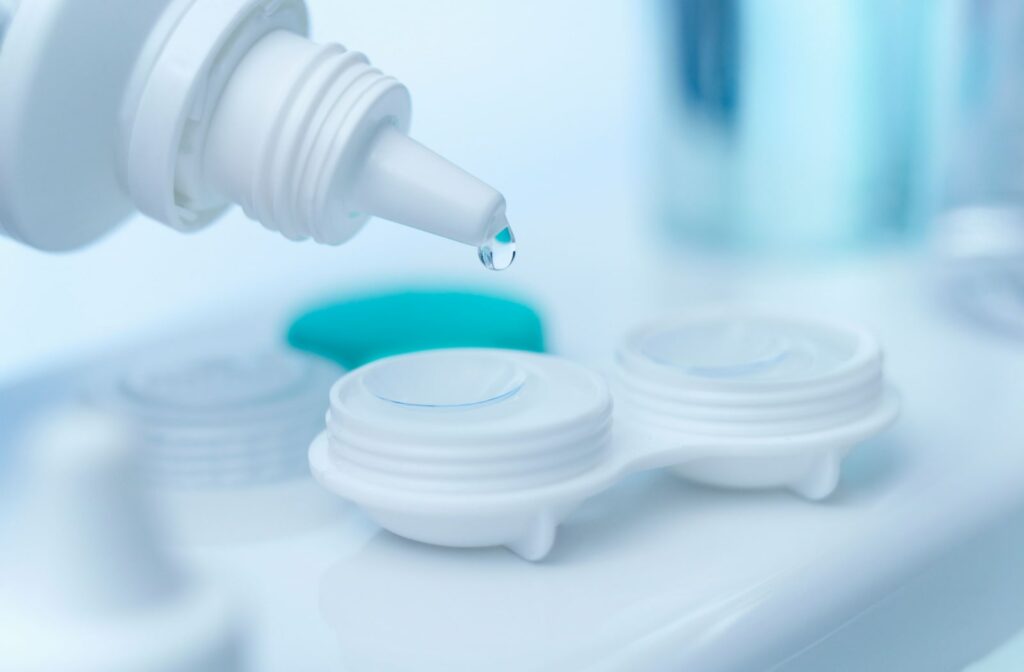Storing contact lenses properly can take time and effort. But it’s important to take the time to learn how to do it right to help extend their lifespan and reduce your risk of developing infections or other complications.
To properly store contact lenses:
- Always wash your hands before touching them
- Always keep them in fresh saline solution
- Replace the case every 3 months
- Clean according to the manufacturer’s instructions
- Discard discolored or damaged lenses
- Store your lenses in a cool, dry place
- Use separate cases for different lenses
When it comes to proper contact lens care, storing your lenses at the right temperature and in the right solution is crucial for safe, comfortable wear. Storing your contact lenses improperly can cause eye irritation, discomfort, and infection.
Wash Your Hands Before Handling Contact Lenses
When you touch your lenses with dirty hands, you can transfer bacteria, dirt, and other harmful substances onto the lenses, which can come into direct contact with your eyes, increasing the risk of developing eye infections such as pink eye or keratitis.
Washing your hands thoroughly with soap and water removes dirt, oils, and germs. After washing, rinse your hands thoroughly and dry them with a clean towel or air dryer.
By practicing good hand hygiene, you can reduce the chances of introducing harmful microorganisms to your eyes through contact lenses. It’s a simple but effective measure to protect your eye health.
Clean the Case Regularly & Always Use Fresh Solution
When you store your lenses in a case, it creates an environment where bacteria, fungi, and other microorganisms can thrive if not properly cleaned. If these contaminants come into contact with your lenses, they can transfer to your eyes during insertion, leading to potential infections or irritations. To prevent this, it is important to regularly clean your contact lens case with a sterile solution and allow it to air dry.
The same thing can happen when reusing old lens solution. It doesn’t effectively disinfect your lenses and can increase the risk of contamination. After each use, always replace the remaining solution with fresh solution before storing your lenses.
Replace the Case Every 3 Months
Replacing contact lens cases every 3 months is recommended to avoid irritation and infection caused by bacteria buildup. Over time, the case can become a breeding ground for microorganisms, even with regular cleaning. Replacing the case regularly reduces the risk of contamination and helps protect your eye health.
Follow the Manufacturer’s Instructions for Cleaning
When cleaning your contact lenses, it’s essential to follow the instructions provided by the manufacturer. These guidelines are specifically designed to ensure effective and safe lens cleaning.
The experts who create these guidelines understand the intricate details of contact lens materials and their specific cleaning requirements. They know how to best disinfect the lenses and remove any potential contaminants. Following the manufacturer’s instructions helps prevent discomfort or irritation from improper cleaning techniques or solutions.
Discard Discolored or Damaged Contact Lenses
If you notice any changes in the color or appearance of your lenses, it’s a sign that they may be compromised and no longer safe to wear.
Discoloration can occur due to protein buildup, dirt, or even exposure to certain chemicals. These changes not only affect the aesthetics of your lenses but can also impact their performance and hinder your vision or cause discomfort, leading to potential eye irritation or infections.
Damaged contact lenses should never be worn either. Tears, cracks, or scratches on the lens surface can compromise their structural integrity and risk your eye health. Even minor damage can create an environment where bacteria can thrive, increasing the likelihood of infection or other complications.
When in doubt, always consult your eye doctor for guidance on discarding discolored or damaged contact lenses. They can provide you with the necessary advice and recommendations for a replacement.
Keep Lenses Cool, Dry, & Away from Extreme Temperatures
Store unopened contacts in a cool, dry place away from extreme temperatures. Extreme temperatures can wreak havoc on your lenses. Heat can warp or deform the shape of your lenses, making them uncomfortable to wear or causing blurry vision. Cold temperatures can make your lenses stiff and brittle, increasing the risk of breakage or tearing.
Use Separate Cases for Different Types of Contact Lens
Storing different types of lenses in separate cases is an important practice, especially if you use various kinds simultaneously, like a daily-use lens alongside a 2-week disposable or any other combination.
Different lenses have unique cleaning and disinfection requirements. Some lenses may require specific solutions or disinfecting methods that differ from others. By storing them separately, you can avoid cross-contamination and ensure each lens receives the appropriate care.
Mixing up different lenses can lead to accidental misuse or improper care. Imagine accidentally soaking your daily-use lenses in a solution meant for extended-wear lenses. Having dedicated cases for each type eliminates the risk of mixing them up and ensures you’re using the right lens at the right time.
Different types of lenses may have varying replacement schedules. Some lenses need to be replaced daily, while others can be worn longer. Storing them separately allows you to track which lenses are due for replacement, preventing you from inadvertently extending their lifespan beyond what’s recommended.
Contact Lens Care Guidance from McCauley Celin Eyecare Associates
McCauley Celin Eyecare Associates has experienced optometrists who can help guide you in proper contact lens care routines and give you the resources to help you keep a tidy contact lens regimen. Contact McCauley Celin Eyecare Associates for your next pair of contacts today!














